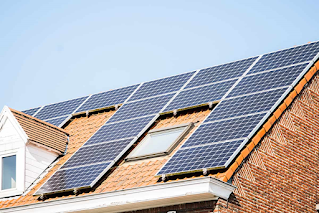How Solar Panels Can Help Reduce Urban Heat Islands
According to pvmarket, Urban areas, with their dense infrastructure, are prone to a phenomenon known as the Urban Heat Island (UHI) effect. This occurs when cities experience significantly higher temperatures than their rural surroundings due to human activities and the extensive use of materials like concrete and asphalt, which absorb and retain heat. As global temperatures continue to rise, the UHI effect exacerbates heatwaves, making cities uncomfortably warm and increasing energy consumption. Fortunately, solar panels offer a promising solution to mitigate this issue.
Understanding
the Urban Heat Island Effect
The UHI
effect is driven by several factors, including the reduced amount of vegetation
in urban areas, which limits natural cooling through shade and
evapotranspiration. Additionally, the dark surfaces of roads and buildings
absorb and store solar radiation, gradually releasing it as heat, which raises
the overall temperature of the city. This leads to increased demand for air
conditioning, higher energy costs, and more significant greenhouse gas
emissions.
How Solar
Panels Mitigate the Urban Heat Island Effect
- Reflecting Solar Radiation: One
of the primary ways solar panels help reduce the UHI effect is by
reflecting a portion of the sun's energy back into the atmosphere. Unlike
traditional roofing materials, which absorb and radiate heat, solar panel for uae are designed to convert
sunlight into electricity. This means less heat is absorbed by buildings,
leading to a cooler environment.
- Shading Urban Surfaces: Solar
panels can be installed on rooftops, carports, and other structures,
providing shade and reducing the amount of heat absorbed by underlying
surfaces. This shading effect is particularly beneficial in areas with
limited greenery, where direct sunlight would otherwise contribute to the
UHI effect.
- Reducing Energy Consumption: By
generating clean electricity, solar panels reduce the need for fossil
fuel-based power plants, which are often located near urban areas and
contribute to the UHI effect through waste heat emissions. As more
buildings adopt solar energy, the overall demand for energy decreases,
leading to fewer emissions and a cooler urban environment.
- Encouraging Green Roofing: The
integration of solar panels with green roofs—rooftops covered with
vegetation—can further enhance their cooling benefits. Green roofs absorb
less heat than conventional roofs, and when combined with solar panels,
they create a synergistic effect, significantly lowering urban
temperatures.
- Promoting Sustainable Urban
Design: The adoption of solar panels encourages a shift towards more
sustainable urban design. Cities can incorporate solar energy into
building codes and urban planning, creating cooler, greener, and more
energy-efficient environments. This not only helps reduce the UHI effect
but also improves air quality and the overall livability of urban areas.
Conclusion
As
urbanization continues to expand, addressing the Urban Heat Island effect
becomes increasingly important. Solar panels offer a dual benefit: they provide
clean, renewable energy while also helping to cool down our cities. By
reflecting solar radiation, shading surfaces, reducing energy consumption, and
promoting sustainable design, solar panels play a crucial role in mitigating
the UHI effect. At pv market, we believe in
the power of solar energy to transform urban landscapes, making them more
resilient, energy-efficient, and comfortable for everyone. Embracing solar
technology is not just an investment in renewable energy—it's a step towards
creating cooler, greener, and more sustainable cities for future generations.




Comments
Post a Comment